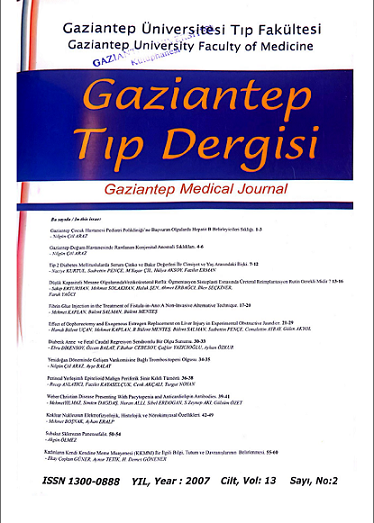Congenital Anomaly Frequencies in Maternity Hospital Of Gaziantep
DOI:
https://doi.org/10.58600/eurjther.2007-13-2-1366-archKeywords:
Congenital anomaly, FrequencyAbstract
Congenital anomaly is a change of anatomical structure, which exists at delivery. in our study, we aimed to investigate the congenital anomalies and their frequencies. To do this, the records of 11,840 live births in the maternity hospital of Gaziantep between June 2003 and February 2005 were screened retrospectively. Major anomalies that were noticed at routine newborn examination were recorded. 6,152 of the newborns were male, and 5688 were female. The mean age of the mothers included in this study was 25.5 ± 8.2 years. The mean age of the mothers whose babies had any anomaly was 31±6.6 years. Congenital anomalies were noted in 123 newborns out of 11,840 (1.0 %). The most frequent anomalies were related to the urogenital system, and the most frequent anomaly of this system was hypospadias (43/82; 52.43 %). Major anomaly frequency is between 1-4 % in alive newborns. This study was conducted in Gaziantep Maternity Hospital, which provides health care to a large population, and the distribution of congenital anomalies were determined and found to be compatible with literature.
Metrics
References
Gökçay G, Neyzi O, Bulut A. Sosyal Pediatri. Neyzi O, Ertuğrul T (edt) Pediatri (3. baskı). İstanbul, Nobel Tıp Kitabevi, 2002:37-43.
McLean SD.( The Newborn infant )-Congenital Anomalies. in: Avery GB, Fletcher MA, MacDonald MG (eds) Neonatology, Pathophysiology and Management of the Newborn (5th ed). Philadelphia. Lippincott Williams & Wilkins, 1999:839-857.
Guyer B, Martin JA, MacDorman MF, Anderson RN, Strobino DM. Annual summary of vital statistics 1996. Pediatrics 1997;100:905-914.
Chung CS, Myrianthopoulos NC. Congenital anomalies: mortality and morbidity, burden and classification. Am J Med Genet 1987;27:505-523.
Van Regemorter N, Dodion J, Druart C et al. Congenital malformations in 10000 consecutive births in a university hospital:need for genetic counseling and prenatal diagnosis. J Pediatr 1984;104:386-390.
Cendron M, Keating MH, Huff DS, et al: Cryptorchidism, orchiopexy and infertility: A critical long-term retrospective analysis. J Urol 1989;142:559-563.
Moshang T, Thornton PS. Endocrine disorders of the newborn. in: Avery GB, Fletcher MA, MacDonald MG (eds). Pathophysiology and Management of the Newborn. (5th edition). Philadelphia. (Lippincott Williams & Wilkins ) 1999:859-884.
Myers NA, Beasley SW, Auldist AW. Oesophageal atresia and associated anomalies: a plea for uniform documentation. Pediatr Surg int 1992;2:97-100.
Craig LC,Goldberg MJ. Foot and leg problems. Pediatrics in review 1993;14:395-400.
The Newborn infant-General Surgery. in: Avery GB, Fletcher MA, MacDonald MG (eds) Neonatology, Pathophysiology and Management of the Newborn (5th ed). Lippincott Williams & Wilkins, 1999:1005-1040.
Hendren WH. Urological aspects of cloacal malformation. J Urol 1988;140:1207-1213.
Persson EK, Anderson S, Wiklund LM, Uvebrant P. Hydrocephalus in children born in 1999-2002: epidemiology, outcome and ophtalmological findings. Child Nerv Cyst 2007 Apr 12; (Epud ahead of print)
The Nervous System-Congenital Anomalies of the Central Nervous System. in: Nelson WE, Behrman RE (eds). Textbook of Pediatrics (14th ed). Pennsylvania, W.B. Saunders Company, 1992:1483-1485.
Downloads
Published
How to Cite
Issue
Section
License
Copyright (c) 2023 European Journal of Therapeutics

This work is licensed under a Creative Commons Attribution-NonCommercial 4.0 International License.
The content of this journal is licensed under a Creative Commons Attribution-NonCommercial 4.0 International License.


















